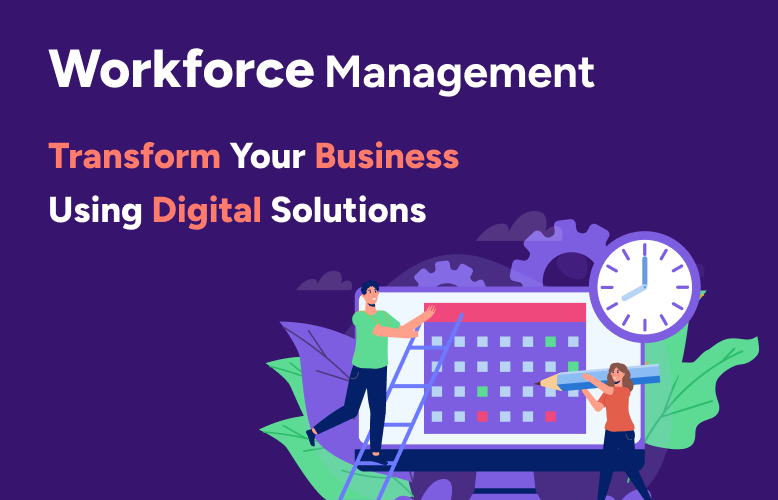
The Future of Workforce Management: Embracing Digital Solutions
As we step into the future, workforce management is undergoing a significant transformation. In particular, the integration of digital solutions is revolutionizing how organizations manage, monitor, and support their employees. This shift is not just about adopting new technologies; rather, it’s about creating a more efficient, productive, and employee-centric work environment. In this article, we’ll explore the trends and tools shaping the future of workforce management.
What is Workforce Management?
Workforce management (WFM) refers to processes and tools businesses use to optimize employee productivity, scheduling, and efficiency. Key components include:
- Employee Scheduling – Ensuring the right number of staff is available at the right time.
- Time and Attendance Tracking – Monitoring work hours and productivity.
- Leave and Absence Management – Handling vacation requests, sick leave, and absences.
- Performance Management – Tracking employee performance and aligning it with business goals.
- Payroll and Compliance – Managing salaries, benefits, and legal requirements.
Traditional workforce management relied on manual processes and spreadsheets. However, digital solutions have made these tasks more efficient and data-driven.
The Rise of Digital Workforce Management
Technology is reshaping workforce management. Furthermore, these companies are investing in AI-powered software, cloud-based HR systems, and real-time analytics to optimize operations.
Key Technologies Driving Workforce Management

Artificial Intelligence (AI) & Machine Learning (ML)
- AI-driven workforce software predicts staffing needs and automates scheduling.
- AI chatbots handle employee queries, reducing the administrative workload.
Cloud-Based Solutions
- Cloud platforms provide real-time access to workforce data, supporting remote management.
- Businesses of all sizes benefit from flexible and scalable cloud solutions.
Automation & Robotics Process Automation (RPA)
- Automating HR tasks like payroll processing and leave approvals minimizes human error.
- RPA integrates workforce data with payroll and performance management systems.
Internet of Things (IoT) & Smart Devices
- IoT enables real-time employee tracking and security management.
- Wearables monitor well-being and safety in industries like healthcare and manufacturing.
Big Data Analytics & Predictive Insights
- Workforce analytics provide insights into performance, attrition, and labor costs.
- Predictive analytics optimize workforce planning and decision-making.
Benefits of Digital Workforce Management
- Enhanced Efficiency: Automates routine tasks, allowing HR teams to focus on strategic initiatives.
- Improved Accuracy: Reduces errors in data management and payroll processing.
- Better Decision Making: Provides real-time insights into workforce performance and productivity.
For instance, companies like IBM utilize digital workforce management tools in order to streamline their HR processes. As a result, this leads to significant reductions in administrative tasks and improvements in employee satisfaction.
The Role of Technology in Workforce Management
Technology is transforming workforce management by automating complex workflows, predicting staffing needs, and optimizing task assignments. As a result, this allows managers to make informed decisions that drive business success.
How Technology Enhances Efficiency
- Predictive Scheduling: Technology can forecast staffing needs based on historical data and real-time trends, ensuring that the right number of employees are scheduled at the right time using employee scheduling tools.
- Task Optimization: Technology helps in assigning tasks based on employee skills and availability, maximizing productivity and reducing workload imbalances.
- Data Analysis: Technology tools analyze vast amounts of employee data to provide actionable insights, helping organizations make strategic decisions.
Technology can also help in identifying underutilized talent within the organization, allowing managers to reassign tasks more effectively and enhance overall productivity.
Flexibility in Workforce Management
Flexibility is key to attracting and retaining talent in today’s dynamic work environment. Companies are increasingly supporting hybrid work models, non-traditional hours, and dynamic schedules. Staff scheduling tools are crucial in managing these flexible arrangements, ensuring that employees can work effectively across different time zones and locations.
Benefits of Flexible Scheduling
- Improved Work-Life Balance: Flexible schedules allow employees to manage their personal and professional responsibilities more effectively.
- Increased Productivity: Employees are more productive when they have control over their schedules, leading to better work outcomes.
- Enhanced Employee Satisfaction: Flexible work arrangements contribute to higher job satisfaction and reduced turnover rates.
Implementing flexible scheduling requires careful planning and communication. Organizations must clearly outline scheduling policies and expectations for employees, ensuring that everyone understands their roles and responsibilities.
The Importance of Employee Engagement
Employee engagement is vital for maintaining a motivated and productive workforce. Employee engagement software and employee management software helps organizations measure and improve engagement levels by facilitating communication, feedback, and recognition. Engaged employees are more likely to be committed to their roles and contribute positively to the organization’s success.
Strategies for Boosting Engagement
- Regular Feedback: Encourage open communication and provide regular feedback to help employees grow professionally.
- Recognition Programs: Implement recognition programs to appreciate employees’ contributions and achievements.
- Employee Well-being: Focus on employee well-being by offering benefits and support that enhance their overall quality of life.
For example, companies like Google use employee engagement strategies to conduct regular surveys and feedback sessions, which helps in identifying areas for improvement and enhancing employee satisfaction.
Recruitment in the Digital Age
This is also being transformed by digital solutions. Recruitment software streamlines the hiring process by automating tasks such as resume screening, interview scheduling, and candidate communication. Additionally, this not only saves time but also ensures that the best candidates are identified and engaged efficiently.
How Recruitment Software Enhances Hiring
- Efficient Screening: Digital tools can quickly screen resumes based on specific criteria, reducing manual effort.
- Personalized Communication: Automated systems can personalize communication with candidates, improving their experience.
- Data-Driven Decisions: Recruitment software provides insights into hiring metrics, helping organizations refine their recruitment strategies.
Companies like Amazon use digital recruitment tools to screen resumes and identify top candidates, resulting in faster hiring processes and improved candidate quality.
Timesheet Management: The Backbone of Workforce Efficiency
Timesheet software and timesheet management software are essential for tracking employee hours, managing payroll, and optimizing resource allocation. Additionally these tools ensure accuracy in time tracking, reduce administrative burdens, and provide real-time visibility into workforce productivity.
Benefits of Effective Timesheet Management
- Precise Payroll Processing: Guarantees employees receive accurate and timely payments.
- Improved Productivity: Helps managers identify areas where productivity can be enhanced.
- Compliance Management: Helps follow labor laws and regulations.
Effective timesheet management is crucial for maintaining compliance with labor laws and regulations. In addition, by using automated systems, organizations can ensure that employees are paid correctly and on time, therefore reducing the risk of legal disputes or fines.
Cloud-Based Solutions for Workforce Management
Cloud-based Human Capital Management (HCM) solutions are gaining popularity because of their ability to automate and standardize HR functions. In addition, these solutions offer a centralized platform for employees and managers to perform self-service tasks, therefore eliminating the need for manual intervention and offline documentation.
Advantages of Cloud HCM
- Scalability: Cloud solutions can easily scale up or down to meet changing business needs.
- Accessibility: Provides real-time access to employee data and performance metrics from anywhere.
- Cost Efficiency: Reduces overhead costs by offering plug-and-play solutions that can be customized to meet unique business needs.
Cloud HCM solutions are particularly beneficial for organizations with remote or distributed workforces since they provide real-time access to employee data and performance metrics regardless of location.
2025 Workforce Management Trends
As we look to 2025, several trends will shape the landscape of workforce management:
- Integration of Technology and Automation: Technology will also play a more significant role in automating HR tasks and providing predictive insights.
- Focus on Employee Well-being and Engagement: Organizations will also prioritize employee well-being and engagement to maintain a motivated workforce.
- Total Talent Management: Companies will also adopt a holistic approach to managing all types of talent, including full-time, part-time, and gig workers.
- Workforce Optimization Powered by Data: Data analytics will be crucial in optimizing workforce allocation and performance.
- Elevating the Candidate and Worker Experience: Organizations will focus on creating positive experiences for both candidates and existing employees.
These trends highlight the importance of embracing digital solutions to enhance efficiency, productivity, and employee satisfaction.
The Impact of Technology on Workforce Management
Technology is also poised to revolutionize workforce management by enhancing employee experience and providing deeper insights into labor costs and optimization opportunities. Additionally, this can improve digital assistant functionality and deliver more personalized support to employees and managers.
Use Cases for Technology
- Personalized Support: Technology can also create customized support materials and guides for employees based on their specific needs.
- Automated Reporting: Technology can also generate detailed reports on workforce performance and trends, helping managers make informed decisions.
- Enhanced Communication: Technology-driven tools can also facilitate more effective communication between employees and management by generating personalized messages and updates.
Technology can also help in creating personalized training programs for employees, enhancing their skills and productivity.
Best Practices for Implementing Digital Solutions
Implementing digital workforce management solutions requires careful planning and execution. Organizations should start by assessing their current systems to identify areas for improvement. This involves evaluating existing HR processes and technology to determine where digital solutions can also add the most value.
Choosing the right technology is also crucial. Additionally, these Organizations should select solutions that align with their business needs and goals, ensuring that the technology integrates seamlessly with existing systems and supports strategic objectives. Providing comprehensive training to all employees and HR teams is essential to ensure a smooth transition to new systems. Finally, regularly monitoring the impact of digital solutions on workforce management and making adjustments as needed helps ensure that these technologies continue to drive efficiency and productivity over time.
Ethical Considerations in Workforce Management
As technology becomes more integral to workforce management, therefore, ethical considerations are crucial. Consequently, organizations must ensure that technology systems are transparent, unbiased, and used responsibly to avoid discrimination or unfair treatment of employees.
Ensuring ethical technology use requires transparency in how technology-driven decisions are made. In addition, organizations should communicate how technology systems work and how they impact employee experiences. Moreover, regular audits are necessary to mitigate bias in technology systems, therefore ensuring they are fair and equitable. Furthermore, involving employees in the development and implementation of technology solutions helps ensure that their needs are met and that technology is used in a way that supports, rather than hinders, workforce management.
Conclusion
The future of workforce management is all about embracing digital solutions to create a more agile, productive, and employee-centric work environment. By leveraging these technologies, organizations can streamline processes, enhance efficiency, and also foster a culture of innovation and growth. As we move forward, staying ahead of these trends will be crucial for businesses aiming to thrive in a rapidly changing world.

